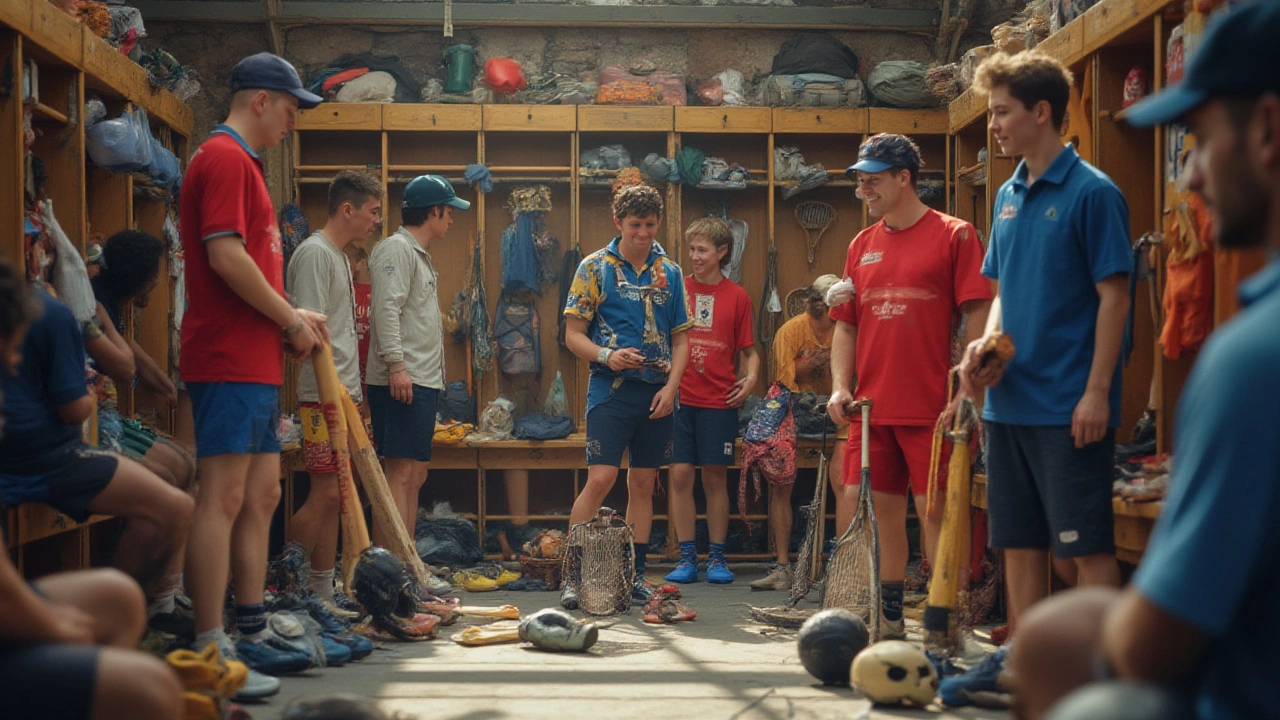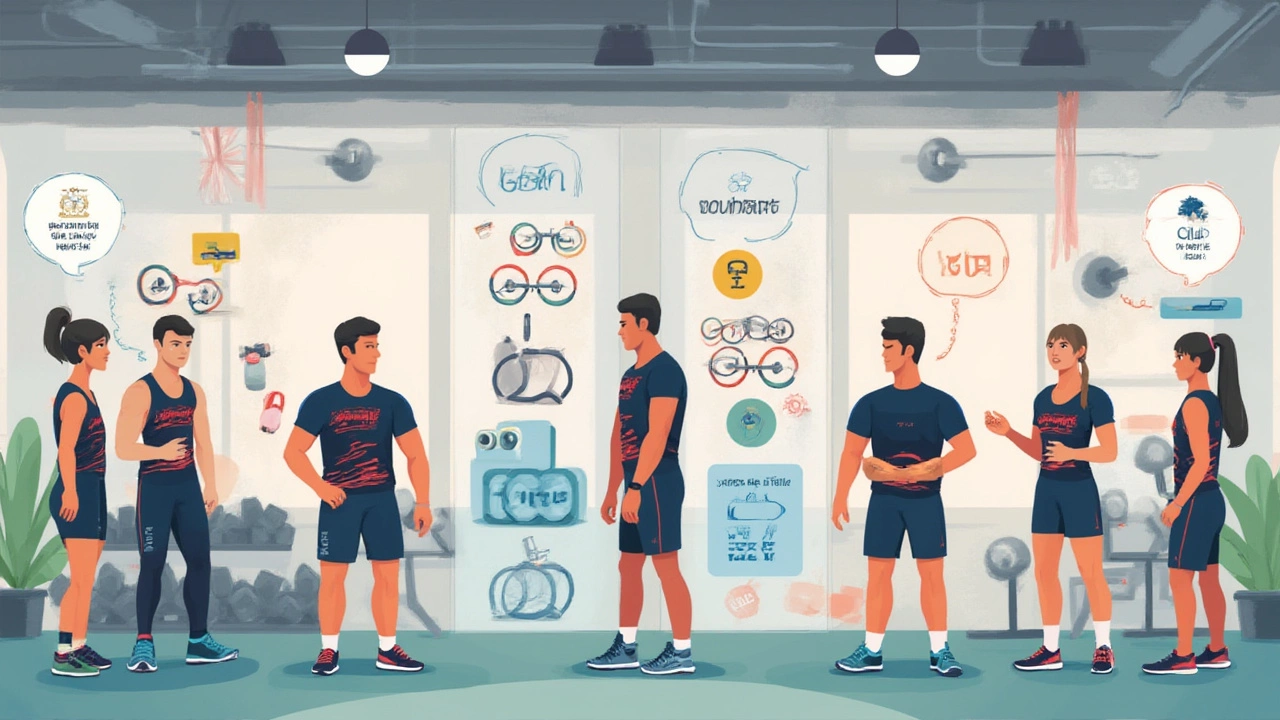Alternative Names for Sports Equipment: Gear, Kit, and More Explained

Ever wonder why some people call it a tennis racket and others just say gear? Step into any gym, club, or even a well-stocked garage, and you’ll bump into a heap of words all meaning one thing: sports equipment. But here's the surprise—nobody really agrees on one name. Depending on who you’re talking to and what country you’re in, you might hear everything from “gear” to “kit,” “apparatus,” “outfit,” or the catch-all “sporting goods.” Sometimes, the same piece of equipment even collects different names depending on the sport or context.
What Else Do People Call Sports Equipment?
Let’s start with the obvious—sports equipment can go by loads of other names. The most popular alternative? “Gear.” Athletes from weekend joggers to the Olympic level toss that word around daily. When someone says, “Grab your gear,” they might be talking about football cleats, swim goggles, or a mountain bike. The word is kind of a glue that sticks to nearly any sporting object you can think of.
Next comes “kit.” You’ll especially spot this term in the UK, parts of Europe, and among soccer (or football) fanatics everywhere. If you hear a coach yell, “Don’t forget your kit!” she’s usually pointing at the bag stuffed with uniforms, balls, shoes, and protective pads. Kit can mean a full set—jersey, shorts, socks, and shoes for a soccer player—or just the set of things you need to play.
“Sporting goods” is another phrase that pops up in North America, especially in retail. Walk into any big-box store with a baseball bat on the sign, and you’re in the sporting goods section. This term draws the widest net—it covers everything from tiny ping-pong balls to archery bows to yoga mats. Big brands even tack this on their signage, like Dick’s Sporting Goods or Academy Sports + Outdoors, making it almost impossible to forget.
Then there’s “apparatus,” which pops up in gymnastics, track and field, and sometimes even swimming (think: starting blocks). This word sounds fancy (and honestly, a bit stuffy), but judges and coaches use it to talk about very specific pieces used in competition. For example, in gymnastics, each discipline uses its own apparatus: vault, uneven bars, and pommel horse. So, apparatus usually means something you use to perform a move or routine, not a broader pile of gear.
And don’t ignore “outfit,” which can mean something wearable (like a baseball uniform) or a sport-specific total look. Cyclists, for example, call their combo of helmet, jersey, and padded shorts an outfit—though others might stick with “kit.”
This jumble of names isn’t just about words—it reflects how different cultures, sports, and retail industries view what it means to play. According to Dr. Mary Jo Kane, Sports Science Professor at the University of Minnesota, “Language in sport changes with time, location, and even with fashion. Calling it ‘kit’ in London gives it a sort of prestige, while ‘gear’ in the U.S. feels casual and ready for action.”
Here are some common alternative names and where they pop up:
- Sports gear (USA, global): think shoes, pads, uniforms, protective equipment.
- Kit (UK, Europe, Australia): especially for teams and in soccer/football, rugby, and cricket.
- Sporting goods (retail, North America): store sections, product packaging.
- Apparatus (gymnastics, athletics): equipment for specific routines or competitions.
- Outfit (cycling, baseball): all wearable gear for a sport.
Curious about how it looks in numbers? Here’s a quick stat overview on how the public refers to their sporting stuff, based on a 2024 Sport Retail Survey in the U.S. and UK.
| Alternative Name | Usage (US %) | Usage (UK %) |
|---|---|---|
| Gear | 67 | 55 |
| Kit | 17 | 64 |
| Sporting goods | 32 | 11 |
| Apparatus | 7 | 10 |
| Outfit | 12 | 18 |
The next time someone asks you to grab your kit, gear, or even apparatus, you’ll know what’s what. It’s not just about what you play with; it’s how you talk about your sport.

Why Does the Name Matter? Context, Culture, and Communication
It may seem fussy, but the words you use can actually make a difference, especially if you’re shopping, traveling, or chatting with teammates from other countries. Go on a trip to London, and if you tell the store owner you need “baseball gear,” they might give you a puzzled look. Say you want “kit,” and suddenly they get it—it’s about the full set, not just a glove or bat. Knowing the right term can save you time, money, and a lot of side-eye.
Cultural quirks play a big role. Soccer fans in the UK and Europe love “kit,” while most Americans only say “kit” when they mean a first aid kit or something for a science project. This difference is why international tournaments and sports leagues spend time training their staff on simple words. If you want to bond or break the ice, use the word your teammates expect.
Language also sets the stage in sports marketing and sponsorship. Brands depend on it: Nike, Adidas, Under Armour—each talks up their “gear” in ads across the U.S., but for the UEFA Champions League, you’ll see “kits” plastered everywhere. It’s not about being picky—it’s about talking to fans in their own language, and honestly, it sells more stuff.
The same logic pops up on team sports registration forms, school supply lists, and even professional contracts. A legal doc might spell out a “kit allowance” for a pro footballer, which covers more than just new cleats—it pays for the whole set: jersey, socks, even sweatbands.
And sometimes, the name signals a shift in the seriousness of play. Parents might buy their little leaguer “gear,” but as the athlete levels up, specialized “equipment” or “apparel” becomes the norm. The word choice often tracks right alongside how pro or casual someone is about their sport.
Consider this bit of wisdom from ESPN’s Marty Smith:
“How you talk about sports stuff says a lot about how you play. ‘Gear’ is for the grind; ‘kit’ is when there’s pride and tradition tied in.”
Sometimes, the stakes are practical: in college or pro sports, policies often draw hard lines between “equipment” (provided by the team), “personal gear” (owned by the player), and “kit” (the uniform set). It’s not just wordplay—each label tracks who pays for what, who’s responsible for cleaning, and who gets to keep it at the season’s end.
Got a mix of terms in your equipment bag? You're not alone. Especially in sports with international teams—think rugby, cricket, or even the NBA—words might ricochet back and forth. It’s normal for an Australian rugby player to say “kit” while his American counterpart says “gear,” and somehow everyone gets on the field just fine.
Here’s a handy cheat sheet:
- Use “gear” for a mix of tools and apparel: baseball gloves, helmets, sneakers, yoga mats.
- Bring up “kit” when you mean the full getup or when you’re in soccer, rugby, cricket circles.
- Opt for “sporting goods” if you’re shopping or talking to a store rep.
- Say “apparatus” for gymnastics, athletics, or events with specific equipment stations.
- Use “outfit” in cycling, running, or discussions about uniformed appearance.
So, the next time you're at a sports shop, don’t be shy—try out the local lingo and see how far you get.

Tips and Facts: How to Choose and Care for Your Sports Gear (or Kit)
Choosing the right gear is more than just picking up what looks cool. It can affect your performance, safety, and how much fun you have. Maybe you’re into running, tennis, or even archery—each sport has its must-haves, and picking them out can feel overwhelming. The right word (kit, gear, or equipment) can even help you get advice from the right salesperson or coach.
Start by making a list based on your sport. Teams often supply a “kit list” before the season starts—it’ll cover essentials by category (protective gear, footwear, uniform, etc.). If you’re shopping, aim for quality over quantity. Don’t get distracted by trends; focus on what keeps you safe and comfy. Tennis? A quality racket matters more than name-brand wristbands. Running? Well-cushioned shoes beat fancy water bottles.
Safety is another biggie. In rugby or football, don’t cut corners—good headgear or mouthguards lower your risk of concussion or lost teeth. The CDC has linked properly fitted protective equipment to a 62% lower injury rate among high school athletes.
| Sport | Essential Gear/Kit | Safety Tip |
|---|---|---|
| Football | Helmet, pads, cleats | Check helmet fit before every game |
| Tennis | Racket, shoes, balls | Replace grip tape regularly |
| Running | Running shoes, moisture-wicking clothes | Replace shoes after 300-500 miles |
| Cycling | Bike, helmet, padded shorts | Always wear a helmet, even on short rides |
| Gymnastics | Leotard, chalk, grips | Inspect apparatus before routines |
Another tip: keep your gear clean and organized. For uniforms (or kit), wash right after games or practice to keep fabrics fresh and lasting longer. For hard equipment (think hockey sticks or rackets), check for cracks or damage after use and before play. Storage bags labeled “kit” can help keep your stuff together and ready—just ask any organized soccer mom or dad.
If you’re buying used sporting goods (a smart move for beginners), always inspect before purchase and check return policies. Some shops—especially those specializing in “sporting goods” and “pre-loved kit”—even offer trade-in credits when your child outgrows last season’s cleats.
When you join a new league or team, ask about their words—do they send out a gear list, kit list, or equipment sheet? Get comfy with the lingo, because it makes chatting with coaches and fellow athletes way easier. Pro tip: some sports, like rugby and cricket, insist on “kit washes” where everyone turns in their uniforms for bulk cleaning. Don’t get caught out because you thought “kit” just meant your water bottle and shin guards.
If you’re heading abroad or doing an international tournament, look up the terms used in your destination country. That little bit of vocabulary can be the difference between finding what you need and getting lost in translation.
So, when it comes to naming your sports stuff, don’t sweat the details—just know the options and play along. Whether you call it gear, kit, or just your lucky cleats, the most important thing is how you use them, not what you call them. And if all else fails, call it “my stuff”—everyone pretty much gets that.
